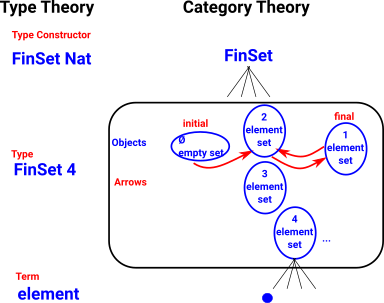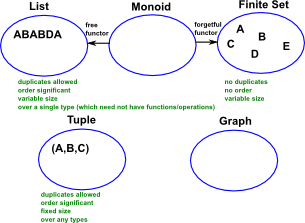On these pages we look at concrete categories. Concrete categories are a set together with some form of 'structure' such as functions and operations within the category. (ref nLab).
Although category theory does not look inside objects I want to be able to translate between category and (for example) set theory. It seems to me that, to really understand a mathematical topic, it helps to be able to approach it from many directions.
So, although we don't look inside objects and arrows, to get some intuition it helps to take a peek.
Also its not practical to do everything in category theory so we still need to translate between different approaces. After all, if an engineer is calculating the loading of a bridge, they probably don't want to calculate it 'up to isomorphism'.
Examples
| Category | Internal Category | Notes | |
|---|---|---|---|
| Objects | Arrows | ||
Set See page here for more. |
1,2 ... n elements |
functions (possibly injective/surjective) |
All structure comes from the arrows. |
| Group |  One set and (possibly) multiple endofunctions. These must be permutations. |
 |
|
Directed Graph See page here for more. |
 Two functions, source and target) from the set of edges to the set of verticies. |
|
An example of a functor category. |
| Natural Numbers |  |
||
Categories and Types
So lets look at how objects and arrows in category theory may, or may not, relate to types and terms in type theory.
In type theory we have types and terms (and perhaps a higher level type constructor) so a sort of three layer hierarchy. In category theory:
- The type constructor might correspond to the category (FinSet category)
- A type might correspond to an object in category theory.
- A term (element of the set) is not explicitly referenced in category theory (we only look at the external properties, not what's inside it).
Consider finite sets:
FinSet
In a finite set category objects are:
|
 |
The arrows are the mappings between these objects.
| Of course category theory does not look inside objects or arrows to see the elements but, to try to give better intuition, lets make an exception in this diagram:. |  |
For further discussion of the properties of sets in category theory see this page.
Natural Numbers
Not all catergories relate to type theory in the same way as FinSet.
In the case of natural numbers:
|
 |
Monoid
In set there were few restrictions on arrows (apart from no arrows to empty set).
However when we add extra structure to the set this puts constraints on what arrows we can have.
We can think of a monoid as a set with some extra structure . So we can start with an underlying set then represent the monoid operation by arrows which constrain what is allowed to comply with the axioms.
| However the monoid category is more usually modeled as a single object with multiple arrows from and back to itself (endo-functors). |
Other Concrete Categorories
Finite Categories
| Name | Diagram | Description |
|---|---|---|
| 0 | No objects No arrows |
|
| 1 | One object For instance: if the object is 'set' then the whole thing is a monoid. |
|
| 2 | Two objects here are some examples: |
|
| 1+1 that is the disjoint union of two single objects | ||
| This could be an index category | ||
 |
This could be a graph | |
| 3 |  |
Three objects. |
Here we avoid loops (exept identity) which would mean that something else is going on (such as isomorphism or adjunctions).
Preorder
In set theory (see page here) a preorder is a set equiped with a binary relation '<=' which is
- reflexive: a<=a
- transitive: if a<=b and b<=c then a<=c
In category theory a preorder only has, at most, one arrow between any two objects.
So, if an arrow exists it is uniquely determined.
Categories with binary operation and identity element
| single objects | multiple objects -> | |||
| composition law | no composition law | |||
| invertible | Groups |
all morphisms are isomorphisms |
Graph | |
| non-invertible | Monoids | Categories | Directed Graph |
Illustrating Category Constructions
In order to get an intuitive understanding of category theoretic constructions I find it helps to use examples from the simplest concrete categories to show what is going on internally, especially if it can be illustrated graphically. Of course, we are not really supposed to look inside categories, but I think its necessary to get an intuitive understanding.
Often sets are the simplest category to show whats going on.
If sets don't have enough structure the a pre-order (see this page) is often a good example to use (on this page I have tried to use preorders to show the idea of adjunctions). pre-orders are good because of the graphical nature of Hasse diagrams.
Pre-orders are also good because they are a specific (less general) case of categories in that, like categories, they are reflexive and transitive:
reflexive |
a≤a If a relationship is reflexive then there is always an arrow from an element of a set to itself. Although when drawing the Hasse diagram we may not draw it to avoid clutter. |
transitive |
if a≤b and b≤c then a≤c This is like composing functions. That is: if the is an arrow from 'a' to 'b' and an arrow from 'b' to 'c', then we can attach the tip of the first arrow to the second arrow to get an arrow from 'a' to 'c'. |
x
 |
On these pages we look at concrete categorories. A definition of concrete categorories is a set together with some form of 'structure' such as functions and operations within the category. (ref nLab) |


